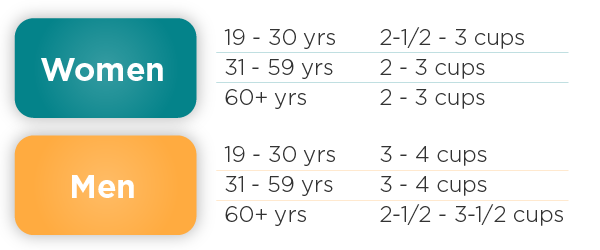Vegetables are one of the most important yet sometimes least eaten food groups. They are packed with many vitamins and nutrients that help our bodies function optimally, and when consumed regularly, they can reduce the risk of developing chronic diseases. They are naturally low in fat and calories and high in fiber which can reduce blood cholesterol levels, lower our risk of heart disease, and help with weight loss or maintenance.
The recommended amount of vegetables a person needs to eat depends on their age, sex, height, weight, and physical activity level. It may also depend on whether someone is pregnant or nursing. MyPlate.gov provides the Daily Recommendations below:

But how do we measure each vegetable to know we are getting our recommended intake? You can find the
Cup of Vegetable Table on the MyPlate.gov website to view what counts! It is split into five vegetable categories:
- Dark-Green Vegetables
- Red and Orange Vegetables
- Beans, Peas, and Lentils
- Starchy Vegetables
- Other Vegetables (items such as cauliflower, cucumbers, onions, etc.)
As always, we want to incorporate vegetables in their whole, fresh form as much as possible. Vegetables can also be eaten raw, cooked, frozen, canned, dried, cut up, or mashed.
Here are three tips for adding more vegetables to your daily nutrition.
- Plan Your Produce – Look at the week ahead to see what meals you can make. Planning out your meals and produce can help you have healthy options, save time in the kitchen and grocery store, and save money by reducing food waste.
- Add One Snack – Add one vegetable snack daily to boost your daily intake. It can be as simple as adding raw carrots, peppers, or cucumbers to an afternoon snack. Pair it with your favorite dips like yogurt, ranch dressing, or hummus.
- Keep the Freezer Stocked – Keep frozen steamable vegetables at home for a quick and easy side dish. These are easy to prepare and make fewer dishes when doing kitchen clean-up! You can also add frozen vegetables into smoothies to add vegetable serving to your day.
Look at the MyPlate.gov recommendations for you, and try to make your meals and snacks veggie-focused!
By, Coach Sarah